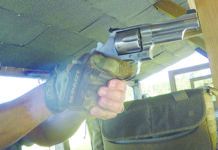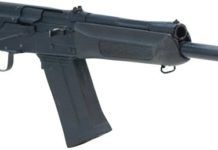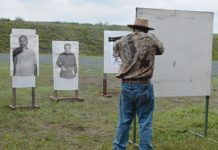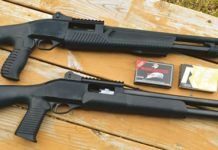Most self-defense shotguns have a few traits in common—short and maneuverable, high capacity, and simple to operate. In the dead of the night, or, increasingly, in the middle of the afternoon, you need to be able to pick up your shotgun, make it hot, and get to the spot in your house or property where you and several of your friends named Buck will treat intruders pretty ugly.
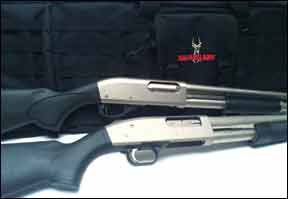
At Gun Tests, we have reviewed dozens of guns made for such unpleasantness, and our staff shooters have liked many of them, as a poke through the online archives at www.Gun-Tests.com or www.GunReports.com will show. One of the assumptions that we made in those reviews is that the guns are well maintained, which for blued steel means enough attention and love to keep them from corroding closed. But for tens of millions of Americans who live on or near coastal areas with salt air or inland on rivers or lakes with attendant high humidity, blued steel might not be the right choice. Something more inert might be better.
Toward that end, we recently acquired two shotguns made of stainless steel, nickel, polymer, and aluminum that promised, and delivered, much of what we want in a self-defense shotgun plus low, low maintenance. One was Mossberg’s Special Purpose Model 500 Mariner 50273 3-Inch 12 Gauge, $571, a six-shot Marinecote-finished pumpgun with stainless barrel and aluminum receiver. We paired it against the Remington Model 870 Special Purpose Express Marine Magnum No. 25012 3-inch 12 Gauge, $772, a handsome shotgun crafted from a steel billet and all its metal parts are nickel coated, including the inside of the barrel and the receiver. There is no toehold for corrosion on this shotgun.
We gave our testers the charge of deciding which gun we’d stow in the cabin of a Hunter 50CC for an extended trip asea, or along for the ride in a bateau headed out to a fishing cabin, or tucked in the corner of the bedroom as a life insurance policy.
The Guns
Mossberg’s Special Purpose Model 500 Mariner 50273 Pump-Action 3-Inch 12 Gauge, $571, is one of the time-tested veterans of home-defense firearms, and its simple design has proven to be popular. It’s one of two Special Purpose Mariner choices in the Mossberg lineup, the other being the higher-cap No. 50299, $627, a 9-shot 20-inch-barrel unit. There’s also a 590A1 Special Purpose stainless gun, which adds a metal safety button and trigger guard, heavy-wall barrel, and a sling swivel-equipped magazine cap for another $29. Also, the Just-In-Case series includes a Mariner pistol-grip shotgun that’s just 28.75 inches OAL, No. 52340, $580. The most expensive stainless shotgun in the Mossberg line is the 6-shot 50278 Special Purpose Tactical gun, which comes with an adjustable tactical stock and a loop-equipped forend. It’s listed at $679. Factory accessories we might consider for our Mariner would include a stainless Picatinny rail (No. 95201, $35), and Barrel Heat Shield (No. 95068, $34).
Our test gun had an overall length of 38.6 inches, with an 18.5-inch Marinecote matte-stainless barrel. The length of pull was 13.75 inches, with a drop at the comb of 1.5 inches and drop at the heel of 2.25 inches. The Marinecote silver finish is highly corrosion resistant, as we detail below.
Remington’s Model 870 Special Purpose Express Marine Magnum No. 25012 3-inch 12 Gauge, $772, is the only product in that line now that the 870 XCS Marine Magnum No. 81308 (2007) was discontinued for 2011. It was dimensionally similar to the 25012 but had a Black TriNyte finish. It’s a little tricky to place the Marine Magnum in the lineup of Remington shotguns. It’s clearly a higher grade gun than the Express models, which, like the Mossberg, have aluminum receivers. The MM has a steel receiver like a Wingmaster, plus the slick, shiny electroless nickel coating that makes it suitable for marine use. But the MM also employs a plastic trigger guard like the Express line. Internally, the MM is finished more like a Wingmaster, with smooth, polished surfaces that to our eyes were clearly better executed than the Mossberg’s.
The MM also had other Wingmaster cues, including a gorgeous polished bore, nickel-plated bolt, one-piece barrel, and milled extractor. But it also had some aspects of the highest-end 870 Police, including the old-style magazine retention system, a short police-length forend, the Remington “R3” recoil pad, what appeared to be heavy-duty magazine, trigger-sear, and shell lifter springs, a milled extractor, and sling-swivel mounts. But it lacked the Police’s aluminum trigger group, stock choices (such as Speed-feed), sight choices, and Police options like magazine extenders and forearms with built-in lights. In fact, Remington’s spec sheets note that the MM won’t accept certain LE accessories.
We measured the 870 to be 38.5 inches in OAL with an 18.0-inch barrel. The synthetic stock had no cast that we could detect, and had 1.5 inches of drop at the comb, 2.0 inches of drop at the heel, and 7.2 inches of drop at the toe. Pitch measured 3.5 inches, slightly more than the Mossy’s 3.1 inches. LOP was identical at 13.75 inches. The Remington was heavier unloaded, 7.25 pounds to the 500’s 6.9 pounds, and loaded, of course, it was heftier at 8.1 pounds compared to the Mossberg’s 7.6 pounds, both measurements a likely result of the 870’s steel receiver and the one additional shell it carried. It did not come with a separate pistol grip, but a Cordura sling was included.
How We Tested
We conducted our usual operational tests for SD shotguns, having a variety of testers shoot them with a lot of different ammunition. In particular, we were looking for failures to function of all types, but especially failures to eject, a short-stroking problem common to smaller, weaker, or less experienced shooters using pumpguns.
Our first step was to spend time oiling and dry-firing each shotgun. If you have ever spent much time cycling a pump shotgun, then you know that these guns are intimidating weapons and they offer great workouts as well. Perfecting a smooth, quick pump stroke is the key to keeping the gun on target, and a lot of dry-fire practice will quickly build your wrists, triceps and quads. You need to pull the stock tightly into your body and make sure the slide goes all the way back and all the way forward with control in between.
The most punishing segment of this testing was group shooting from a rest at 50 yards with slugs. We found setting up a proper rest for pump shotguns to be different from that of supporting a semi-auto shotgun or fully stocked rifle. Resting the guns on the slide was necessary due to their short barrels, and as soon as the trigger breaks the slide is released, destabilizing the gun. Furthermore, whenever you fire from a rest rather than standing, recoil is concentrated in one direction only. This served to magnify the unpleasantness of blast. To offset these problems, we fired groups from a seated position by assuming a normal hold at the forend and grip, and gently rested the front end on sandbags. Our hold for all front-bead groups was 6 o’clock.
We bought our 12-gauge test ammunition from Brownells, which has recently begun selling ammunition. The slug rounds labeled as defense choices were the Brenneke Tactical Home Defense rounds and Winchester Rifled Slugs. We also fired a self-defense-labeled shotshell, the Fiocchi Optima High Velocity round.
For hunting or target use, we chose Winchester AA Target loads and the 3-inch Federal Prairie Storm FS Lead with Flitecontrol shells.
For accuracy testing, we chose the Brenneke 2.75-inch USBSL122THD load (#105-202-379, $7.49/5 rounds), which had a 1-ounce slug moving at a Muzzle Velocity (MV) of 1240 fps and Muzzle Energy (ME) of 1535 ft.-lbs. Though the round is called Tactical Home Defense, Brenneke says the slug offers specific characteristics for use by law-enforcement professionals, in that the wad is designed not to separate from the slug, and its lower recoil allows fast and accurate follow-up shots.
We initially shot this round off the bench with both guns at 25 yards, then we moved back to 50 yards and continued shooting the Mossberg, the reasons for which we detail below. With a red dot or a scope, we think this round’s trajectory justifies shooting it out to 100 yards, since it only drops about 7.5 inches at 100 yards (with a 50-yard zero). That allows a top-of-center-mass hold on a target a football field away, which looses a 438-grain projectile still making 850 fps and 716 ft.-lbs. of energy at that distance.
For function testing, we also fired Winchester Winlite Rifled Slugs No. WINWL12RS (#105-202-849, $4.79/5), 2.75-inch shells that propelled a 1-ounce slug at 1200 fps MV and 1400 ft.-lbs. ME. The Fiocchi Optima FL12HV4 2.75-inch case (#105-201-020, $11.79/25) had a 3.75-gram-equivalent powder charge pushing a payload of 1.25 ounces of No. 4 shot at 1325 fps.
Because these guns are also likely to be used with ammo that’s on hand, we fired two more hunting and target rounds. Winchester AAs are a light load we use a lot for sporting clays, trap, and skeet. This WINAA1275 selection shoots a 11⁄8-ounce payload of 71⁄2s over a 2.75-ounce dram eq. charge, developing 1145 fps (#105-202-441, $8/25). At the other end of the power spectrum was the Federal Prairie Storm FS FEDPF129FS4, a 3-inch waterfowl and pheasant load with both No. 4 copper-plated lead and nickel-plated FS lead shot (#105-200-623, $25/25). The powder charge was 4.29 gr. eq., which pushed the 15⁄8-ounce shotcharge at 1350 fps MV.
For the short-range patterning testing, we shot the guns using a standard shoulder-pocket mount and the Mount-lock technique taught by Hoffner’s Training, www.Hoffners.com. In the latter technique, the shooter drops the elbow and puffs up the pectoral muscle, using it as a pad for the butt. This protects the shoulder joint and creates a more compact stance for maneuvering in tight spaces. We also shot the Mossberg from the down position, held chest-high with its pistol grip installed.
Our targets for the patterning segment were from GunFun’s zombie line (www.GunFun.com). Our contestants included Rhonda, an ax-wielder with yellow skin and red glowing eyes, a crazed Businessman who worked himself to “undeath,” and Boris the butcher. How the two guns performed on zombies and standard ringed targets is covered below, along with our staff’s comments on the guns’ function.
Controls
During our dry-firing drills bent on breaking in the pump action of our test guns, we noticed one very impressive aspect of operating the Mossberg. Both the safety and the slide release could be operated without a change in grip and without having to dismount the shotgun. This was a big edge for the Mossberg right out of the gate.
The Mossberg safety is on the top of the receiver and was worked with the thumb. To make the gun Safe, the safety button must be moved fully rearward into the safety detent. The button then covers a red dot located at the bottom of the safety detent. Moving the safety button forward toward the muzzle of the shotgun will put the safety in the Fire position. On Remington shotguns the crossbolt safety is just above and to the rear of the trigger, requiring the use of the trigger finger to operate it. We found making Remi’s safety ready to Fire to be slower than the 500’s.
The action-release button on the Mossberg was on the left rear side of the trigger guard, leaving the trigger finger behind the trigger guard when chambering a round. The tab to unlock the 870’s slide without firing a round is in front of the trigger guard on the left side. It can be operated by moving the right hand forward and covering the trigger guard with the palm or by holding the gun at the grip and using the left-hand’s fingers. Both controls worked as expected, but we preferred the 500’s execution over the 870’s. The Mossberg’s action-release button was twice as thick and smoother than the 870’s.
Furniture
We didn’t like the Mossberg’s 8.1-inch-long, 1.8-inch-diameter rounded ribbed black synthetic forend. Our testers said it did not feel comfortable in the hand and did not seem to fit right during cycling. We preferred the U-shaped profile of the 870’s ribbed forend, which was essentially the same thickness but over an inch shorter.
On the other end, we also liked the 870’s buttstock design better. The Mossberg’s fixed-stock grip lacked any texture, whereas the 870’s grip had a molded-in panel with light texture. Our testers said they didn’t have an issue with sweaty hands slipping off the 870, a comment they didn’t transfer to the Mossberg. Of course, a couple of wraps of skateboard tape on the 500 solves that problem for pennies.
A bigger edge for the 870 was its cushy Supercell recoil pad, a notable upgrade over the Mossberg’s pad. The Supercell is slick but very soft, whereas the Mossberg pad was twice as stiff and had edges that would need to be ground off, in our opinion. We didn’t shoot a lot of magnum rounds with these guns, but the Mossberg was less comfortable to shoot with 3-inch shells, our testers said, in large part because of its pad’s stiffness.
Handling
The tide ran toward the 870 during handling exercises. Our team said the Mossberg felt more nose heavy than the Marine Magnum, and in fact, we undershot some targets as we cycled a round home from the low-ready position. While the extended magazine provided increased firepower, the added weight and uneven balance of the fully loaded firearm counterbalanced this benefit, in our view. Most self-defense shooting situations involve one or two shots, putting into question the necessity of a firearm that can hold six or seven rounds. Weighing capacity against handling will be a personal preference.
Range Results
Performance with shot loads were indistinguishable on the zombie targets. In a self-defense setting under 25 yards, either shotgun would devastate whatever they were pointed at. Slugs were a different matter.
At 25 yards we could put slugs into a target consistently using just the front bead on either gun, but we wouldn’t call the resulting shots a group. Without a rear sight, there’s just not enough aiming precision for that. On the Remington the 0.14-inch-wide nickel front bead offers some help indexing on a target because it’s mounted on a stanchion, which can provide some line-up relationships on target edges. But the top of the MM’s receiver is rounded, with little or no visual cues for guidance, other than a 0.325-inch-wide shallow channel cut into the top.
The front sight on the Mossberg is also a standard 0.11-inch-wide gold bead, but the receiver channel offers index points when trying to center it up. The top strap is flattened and has shallow grooves running along the length. Those grooves and a series of tapping screws offer more hints about proper windage alignment. But with only these simple guides, the Mossberg enabled us to shoot groups around 4 inches with the Brenneke rifled slug, with the 870 about an inch bigger.
But because the Mossberg came drilled and tapped, we slapped on a 4-inch rail and added an Insight MRDS and cut those group sizes in half. Those were really the best we could do with the forend rolling around on the sandbags. Then we moved to 50 yards and still shot groups as small as 2 inches. This was a huge advantage for Mossy, because drilling and tapping the receiver will add $100 in gunsmithing cost to the 870’s already stiff bottom line.
Trigger function directly contributes to, or detracts from, accuracy, but we didn’t see a massive difference between these two. The Mariner’s trigger broke at 5.1 pounds with a distinct amount of travel before a hard break. The Remington’s narrower trigger shoe wasn’t as comfortable to operate, we thought, even though the pull weight was more than half a pound lighter. Its take-up was more like a double-action trigger, with increasing pressure leading to a release somewhere at the back of the stroke.
Finish
The action of the Mossberg pump was a little rough, so we closely inspected the interior workings and saw that the parts were not as polished and smoothly finished as we would like. Because the action was not as smooth as it should be, the shotgun had a tendency to function a little rougher than expected, particularly in rapid-fire situations. It took about 7 pounds of effort to start and operate the rearward movement of the 500’s slide action, and just over 4 pounds of effort to push the action forward. Both of these readings were better than the 870’s, which required just over 7 pounds of rearward effort to actuate and just over 5.5 pounds of forward effort to reload, but our subjective judgment of smoothness in between went to the Remington.
Other Issues
At the outset, the Mossberg would hold only three rounds, two in the magazine and one in the action. To remove the magazine tube block, we unscrewed the bolt at the front of magazine tube and tilted the gun muzzle down. This allowed a wooden dowel fitted with two rubber O-rings to fall out. The 870 came unplugged.
When checking the Remington’s capacity at the office, we inserted six dummy shells into the magazine tube, which it held. However, as we worked the rounds out of the gun with the muzzle down, they stopped feeding because we had pushed the magazine spring too far in. To pop the spring back out, we banged the butt on the ground, which released the spring and made the orange follower reappear in the receiver.
This may explain surprising malfunctions we had with the 870. We would load the guns to magazine capacity then shoot and cycle the action to run through all six rounds in the tube. Several times the third or fourth shell wouldn’t feed, and our shooters would have to elevate the muzzle to drain a shell into the receiver. We may have compressed the magazine follower into the spring, or somehow overcompressed the spring with a mixture of magnums and standard shells. This was a big problem for a self-defense gun, and would likely require the addition of a spring kit to solve.
Corrosion Resistance
At their hearts, these shotguns are standard, well-known pumpgun designs. What makes them unique are their materials. To test their corrosion resistance, we disassembled both guns. Then, every day for two weeks we sprayed a mild solution of salt water on several of the parts and laid them in the sun. There’s no monster under the bed here: both gun finishes resisted this treatment.
Our Team Said
We preferred the Mossberg Special Purpose Model 500 Mariner 50273 Pump-Action 3-Inch 12 Gauge, $571, over Remington’s Model 870 Special Purpose Express Marine Magnum No. 25012 3-inch 12 Gauge, $772. Part of this is due to price: We found price listings for the Mariner on www.GunAuction.com (formerly www.AuctionArms.com) running between $414 and $452 NIB. Prices at www.GunAuction.com and other sites ran from $500 for a “like new” model to $630 for a NIB sample. In addition to money, the Mossberg had several other advantages that gave it the edge, our testers said. Its drilled and tapped receiver makes adding a sight easy, and the addition of such a sight makes the Mossberg much more accurate with slugs. We preferred the Mossberg’s control layout, and the Mariner was functionally perfect, while the Remington Marine Magnum had some bobbles during our shooting sessions. Would we buy a Marine Magnum if we could get it at a good price? Yes. The element-resisting finishes on these guns make them perfect for the maintenance-indifferent sailor, boater, or self-defense shooter. They certainly will kill birds, too, if you kill their bright finishes.
1011-MOSSBERG-SPECIAL-PURPOSE.pdf
1011-REMINGTON-MODEL-870-SPECIAL.pdf






